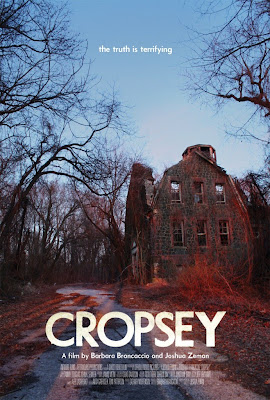Probably one of the most horrifying moments in the documentary, Cropsey, comes about halfway through the film when the viewer sees snippets from Geraldo Rivera's televised expose on The Willowbrook School (an institution that housed developmentally disabled children) from back in the early 70's ; these grainy, washed out images of mentally and physically impaired youngsters writhing about either in their underwear or naked on bare floors, are heart breaking as well as chilling (for the record, I have worked with developmentally disabled people and their families for the past 24 years ). If nothing else, the images point out our inherent inhumanity to those we view as weak, unneeded and undesirable. They point out that we are pretty lousy at caring for our own - that we would all rather look the other way, than take responsibility ; or worse yet, lend a hand and do our part for the least of our brothers. Odd that I should come away from a documentary about a serial killer feeling ashamed of the human race, but that's exactly how Cropsey made me feel.
Co-directors, Barbara Brancaccio and Joshua Zeman certainly have opened up a can of worms with their multidirectional approach of film making; what starts as an exploration of an urban legend (one that seems to have inspired almost every slasher film ever made in the late 70's through the 80's - a crazed killer seeking revenge on those who have wronged him, or possibly a family member), soon becomes a bleak tale of missing children, questionable police work, mob mentality, and, possibly, a Satanic cult.
In a nutshell: in 1987 a developmentally disabled, 13 year old girl named Jennifer Schweiger goes missing and soon her entire community on Staten Island assists the authorities in looking for her. Soon it is reported that Schweiger was last seen in the company of a man named Andre Rand, a middle aged drifter and former employee of The Willowbrook School. Before long, Rand is suspected of other disappearances from the area - all of them mentally disabled children, some who have been missing since the early 70's. Forget the lack of any real evidence, or any credible witnesses, the public needed a monster to blame, and they got one in the silent, brooding Rand. That he was photographed drooling as he was led out of the police station certainly did not help his case...
...after serving several years for the kidnapping (but not murder) of Schweiger, Rand was accused and tried in the kidnapping of Holly Ann Hughes, another child, who had gone missing 20 years earlier. Dubbed the Hannibal Lechter of Staten Island by the press, once again, it appeared that Rand would be done in by circumstantial evidence and the testimony of witnesses who seemed dubious choices at best.
Oddly, at this point, Rand looked less the drooling monster, and more of a slim, silent college professor in appearance.
It does not help that the film makers advance all sort of odd theories, even hinting that Rand merely kidnapped the children and gave them to a Satanic Cult who had been holding black masses at the now abandoned state school. And what about the "witnesses" interviewed for the film? One hot mess of a woman says that she was friends with several of the missing children, even though she gets their names wrong - and then makes a ridiculous claim that she "saw" Rand take one of the children, she knew it was him, even though he was wearing a mask.
Don't get me wrong, it's hard to defend Andre Rand, the man is clearly a creep, but did he kidnap and kill these children? I am not so sure - at least after watching Cropsey, I was not totally convinced.
The filmmakers try and get an interview with Rand, but they ultimately fail. And that's where the movie stumbles. Had we heard from this guy's mouth an admission or a denial, it would have made things easier on the viewer...as it stands, everything seems circumstantial at best. And all we are left with is an angry community out for blood, grieving families aching for closure, and the horrific idea that a handful of disabled children could only be conspicuous in their death, as opposed to the hundreds who suffered out of sight, and out of mind at The Willowbrook School for decades.



3 comments:
I only caught the latter half of this on TV the other night but the images of the Willowbrook School were unlike anything I had ever seen in my life. In. My. Life. But Satanic cult? Really? I thought that was just the insane fantasies of a James Dobson or Tipper Gore. They should have been going after places like Willowbrook. Funny, that.
As usual, the Satanic claims were backed up by no evidence at all, and the interviewees who discussed them were the least credible in the film. I found the material covered in the documentary interesting and disturbing, but the film itself felt a bit slapped together -- it covered too much ground and not very well. I think they could have come up with a much better film about half as long. Maybe the filmmakers weren't mature enough to handle the subject.
Haven't even heard of this one Pax, but how the hell did a documentary about an urban legend get so far derailed? Seems like two completely separate films taped together. With masking tape, no less.
Post a Comment